Size: 71.5 x 70.0 x 3.0 mm.
-
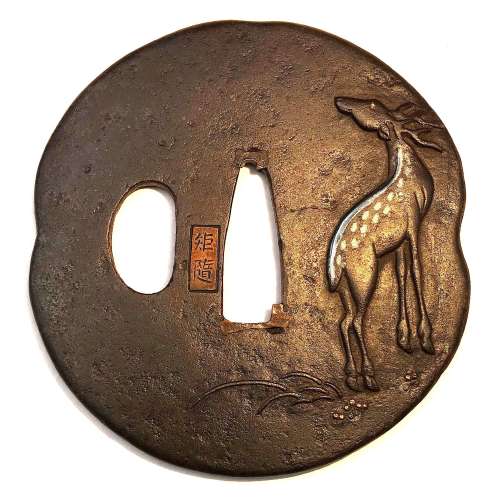 Iron tsuba of ryō-mokko-gata form decorated with a spotted deer (Nara deer or sika deer) motif in low relief carving (sukidashi-bori) and flat silver inlay (hara-zōgan); deer's eyes and details in gold inlay. Signed on a copper cartouche: Noriyuki. Grass in low relief carving on the reverse. There were two Noriyuki in Hamano school - father (Noriyuki I, 1736-1787) and son (Noriyuki II, 1771-1852). Frankly speaking, I don't know which one made this particular piece. Edo period, late 18th or early 19th century.
Iron tsuba of ryō-mokko-gata form decorated with a spotted deer (Nara deer or sika deer) motif in low relief carving (sukidashi-bori) and flat silver inlay (hara-zōgan); deer's eyes and details in gold inlay. Signed on a copper cartouche: Noriyuki. Grass in low relief carving on the reverse. There were two Noriyuki in Hamano school - father (Noriyuki I, 1736-1787) and son (Noriyuki II, 1771-1852). Frankly speaking, I don't know which one made this particular piece. Edo period, late 18th or early 19th century. -
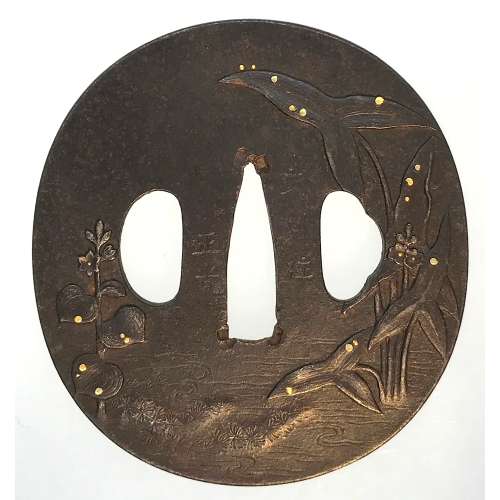
An iron tsuba of oval form decorated with a water plantain (omodaka) carved in low relief and water drops inlaid in gold.
Signed: Bushū jū Masamitsu.
Bushū-Itō school.Height: 71.8; Width: 67.3; Thickness: 3.6; Weight: 96 g.
Mid to late Edo period; 18th-19th century.
There were several tsuba artists with the name of Masamitsu. The one who worked with iron and spelled [正光] is mentioned at Markus Sesko's 'Genealogies' on page 106 in Akasaka School of Edo section as Masamitsu Gorōbei , student of Tadatoki, 4th generation Akasaka master. The name is not mentioned at Torigoye/Haynes 'Tsuba. An Aesthetic Study' in the list of Bushū-Itō family masters on page 181. -
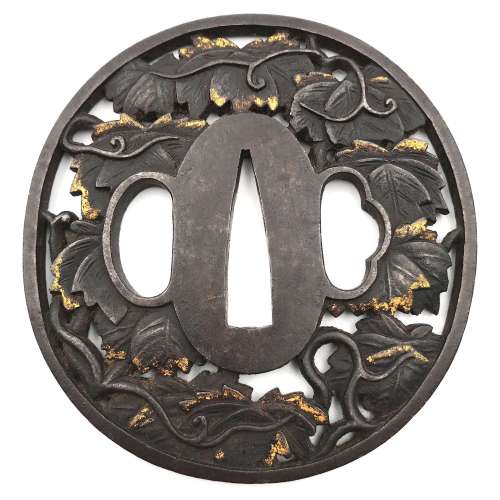
An iron tsuba of slightly vertically elongated circular form carved and pierced with a mass of ivy (tsuta) leaves and tendrils, details damascened with gold in nunome-zōgan technique. Hitsu-ana with raised rim.
Unsigned.
Chōshū school.Height: 72.0 mm; width: 69.0 mm; thickness: 4.7 mm; Weight: 92 g.
According to John W. Dower, "ivy bears fairly close resemblance to both maple leaf and grape leaf". However, I consider this tsuba decorated with ivy leaves for several reasons, such as the lack of racemations in the presence of tendrils. -
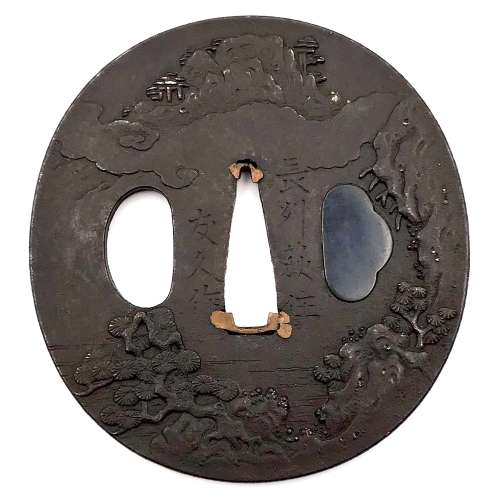
Iron tsuba of oval form carved with a landscape motif. Kogai-hitsu-ana plugged with shakudo. Sekigane of copper.
Signed: Chōshū Hagi-jū Tomohisa saku (長州萩住友久作).
Tomohisa, adopted son of Rokurō'emon, was 3rd generation master of Kawaji School from Hagi in Nagato (Chōshū), lived 1687-1743 [M. Sesko 'Genealogies', page 117].
Edo period, circa 1700. Dimensions: 71.1 x 66.8 x 2.9 mm For his adopted son Hisatsugu work see TSU-0103 in this collection. -
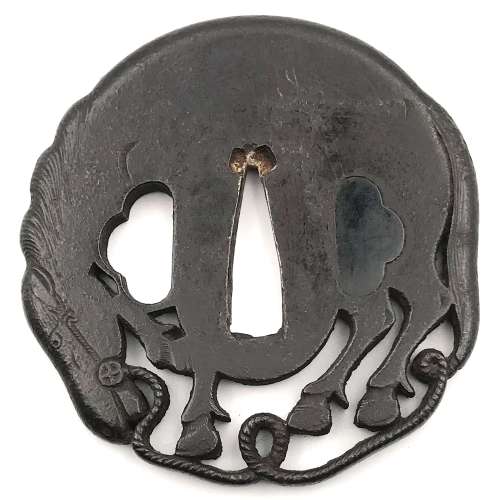
Iron tsuba pierced and carved (marubori-sukashi) with the 'horse in the round' design. Possibly, Bushū-Ito school, 19th century (ca. 1800). Kogai-hitsu-ana plugged with shakudō.
Size: 67.6 x 66.8 x 5.1 mm
Unsigned.
See:
-
- Robert E. Haynes. Study Collection of Japanese Sword Fittings. Nihon Art Publishers, 2010, p. 120: Iron plate carved and formed in the round as a tethered bull...Signed: Bushū jū Sadayasu saku.
- Robert E. Haynes. Masterpiece and highly important tsuba, etc... San Francisco, 1984 // Catalog #9.: Signed: Bushū jū Yoshifusa. Ca. 1800, H 6.7 cm, Th. 4.75 mm.
- The Hartman collection of Japanese metalwork. Christie's, 1976, p. 29, №59: Bushū type, 19th century. Reference to Takezawa, Nihon Toban Zuetsu №411 for a similar design signed Bushū Yoshifusa.
4. Japanese Sword Fittings from the R. B. Caldwell Collection. Sale LN4188 "HIGO". Sotheby's, 30th March 1994, p. 17, №24: An iron tsuba, by Heianjo Sadatsune, Edo period (18th century). In the form of a horse, standing with its head lowered and a rope halter attached to its bit and trailing beneath. Signed Heianjo Sadatsune, 7.3 cm. With NBTHK Tokubetsu kicho paper, dated Showa 49 (1974). GBP 600-700.
Hartman collection, №59.

The Caldwell Collection. Heianjo Sadatsune, Edo period (18th century).
-
-
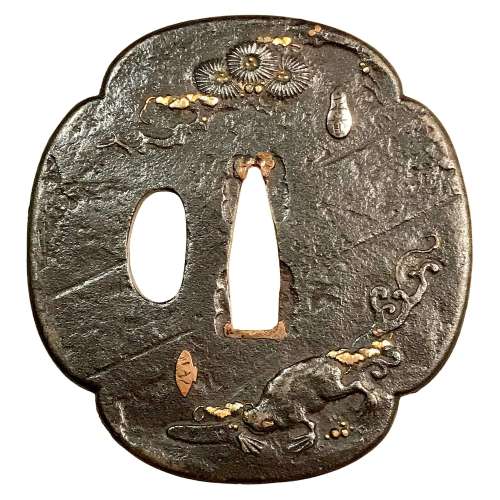
Iron tsuba of mokkō-form with a pine and a frog on the face and a snail on the back, carved and inlaid with gold. Each figurative element of the design is signed on three inlaid cartouches: Masaharu (正春), Kazuyuki (一之), and Yoshikazu (良一) [read by Markus Sesko]. Snake, snail, and frog together make a design called "SANSUKUMI" - Three Cringing Ones [Merrily Baird]. The snail can poison the snake, the frog eats the snail, and the snake eats the frog. It's unclear whether the pine replaces the snake on this tsuba, or the snake is hiding in the pine? Anyway, the frog and the snail are clearly represented. "Maybe we have here a joint work with Masaharu (the silver cartouche next to the pine) being the master and making the plate and Kazuyuki and Yoshikazu as his students carving out the frog and the snail respectively". Copper sekigane.
Dimensions: 70.9 x 67.2 x 3.0 mm. Edo period (18th century).Markus Sesko writes: "I agree, the frog and the snail most likely allude to the san-sukumi motif. It is possible that we have here an artist's choice to deliberately leave out the snake, maybe he thought that the motif is already obvious and there is no need to add a snake to make it clear that the tsuba shows the san-sukumi motif." [Markus Sesko].
Kazuyuki (一之): adopted son of Kumagai Yoshiyuki, student of Ichijō (Gotō-Ichijō Scool) [M. Sesko 'Genealogies', page 19.] Masaharu (正春): Kasuya fam., student of Masamichi (1707-1757) who was the 4th generation Nomura School master in Edo. [M. Sesko 'Genealogies', page 49.] -

Iron tsuba of circular form with a branch of loquat (biwa) pierced in positive silhouette (ji-sukashi) and carved in marubori technique (marubori-sukashi). Kozuka and kogai hitsu-ana are plugged with shakudo.
Signature: Choshu Kawaji ju Hisatsugu saku. Chōshū school in Nagato province.
According to M. Sesko 'Genealogies' Hisatsugu was a 4th generation Kawaji School master from Chōshū (present day Nagato), with the name Gonbei, formerly Toramatsu, adopted son of Tomohisa (1687-1743) [page 117]. For Tomohisa work see TSU-0104 in this collection. -
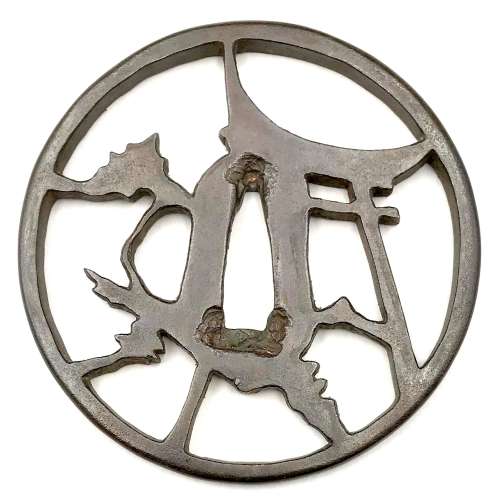
Iron tsuba of round form decorated with the design of distant pines, torii, and crescent moon in openwork (sukashi). Copper sekigane.
Size: 84.9 x 84.8 x 5.8 mm.
Unsigned.
Edo period, ca. 1750.
Tosa Myochin or Akasaka school.Japanese Swords and Sword Fittings from the Collection of Dr. Walter Ames Compton (Part I). Christie's, New York, March 31, 1992, pp. 28-29, № 53:
"A Tosa Myochin School Tsuba. Edo period (circa 1750), signed Toshu ju Kuniyoshi saku. The round iron plate pierced with a design of a temple gate (torii) and a pine tree. It has a round rim and there are some carved details on the surface of the design. The Tosa Myochin school, despite its foundation in the classic Myochin armor school tradition, worked mainly in the style of Akasaka school of Edo. [...] Many are equal to the mid to later Akasaka school work and the two types have frequently been confused. Signed examples are rare. Estimated price $1,500-2,000."

Compton Collection, Vol. 1, №53
-
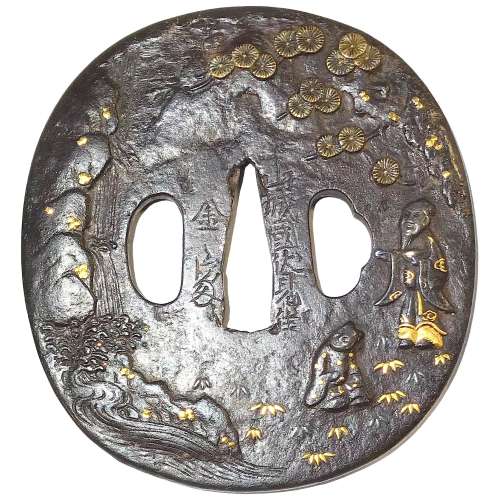
Large oval form tsuba decorated with two human figures (scholar and attendant) under the pine tree admiring a view of a waterfall on the face of the plate, and with stylized dragons carved on the reverse among the symbols of thunder inlaid in gold. The plate is carved in low relief with details inlaid with gold and silver.
Signed: Yamashiro no kuni Fushimi no ju Kaneie [Kaneie of Fushimi in Yamashiro Province] [山城國伏見住金家], with Kaō. It is a fake signature (
gimei). Size: Height: 91.9 mm; Width: 85.6 mm; Thickness: 3.4 mm; Weight: 169 g.
This is a late Edo period, 19th-century export work to cater to the tastes of the European tsuba collectors. It does not have anything in common with the work of great Kaneie masters.
SOLD -
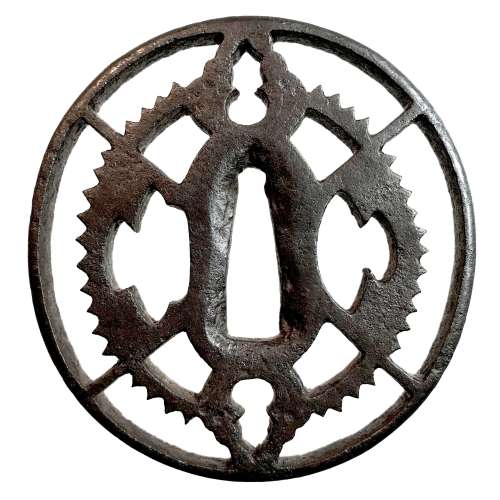
Iron tsuba of oval form pierced with design of slanting rays of light (shakoh), a Christian motif (Jesuit’s IHS symbol), and a pair of tassels in positive silhouette (ji-sukashi). Details on tassels carved in low relief. Traditional description of this kind of design is called “tokei”, or “clock gear”. Rounded rim.
Unsigned.
Edo period, 17th or 18th century. Possibly - Owari school.
Size: 76.0 x 73.0 x 6.2 mm. -
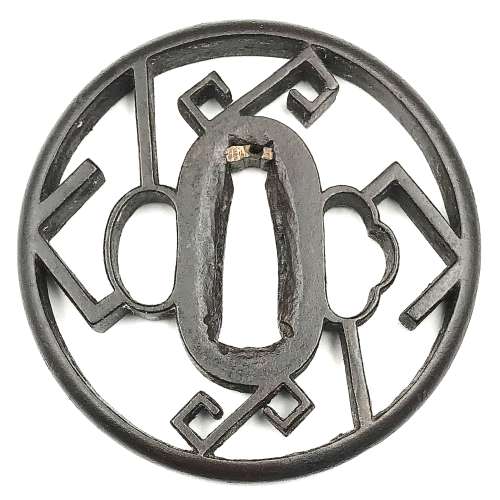
Iron tsuba of round form decorated with design of keys to the storehouse of the gods in openwork (sukashi). Rounded rim. Copper sekigane.
Unsigned. Early Edo period, 17th century.
Size: 71.0 x 70.9 x 6.0 mm.Merrily Baird, Symbols..: The Key to the Storehouse of the Gods, one of the Myriad Treasures.
-
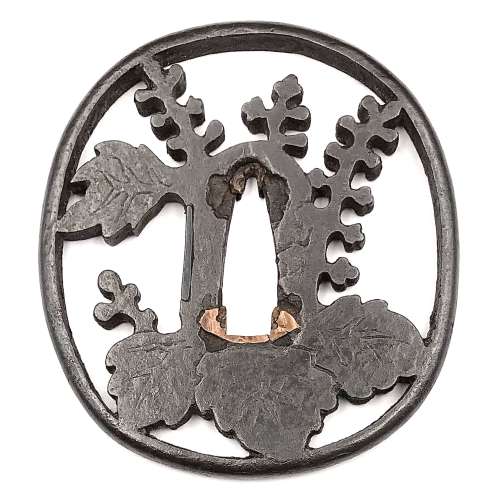 Iron tsuba of oval form with design of stylized paulownia (nage-giri) in openwork (sukashi). Leaf veins carved in kebori technique. Rounded rim. Copper sekigane. Unsigned. Attributed to Kanshirō, third generation Nishigaki (1680-1761). Edo period: Early 18th century (Kyoho / Genbun era). Size: Height: 77.8 mm. Width: 71.9 mm. Rim thickness: 5.9 mm. Center thickness: 5.0 mm. Provenance: Sasano Masayuki Collection, № 264: "Nishigaki. Third generation Kanshiro (died in in the eleventh year of Hohreki, 1761 at the age of eighty-two). This oblong shape appears a little amateurish at first, however, it was done intentionally to add flavor to to the design. The neat composition is a feature of the third Kanshiro."
Iron tsuba of oval form with design of stylized paulownia (nage-giri) in openwork (sukashi). Leaf veins carved in kebori technique. Rounded rim. Copper sekigane. Unsigned. Attributed to Kanshirō, third generation Nishigaki (1680-1761). Edo period: Early 18th century (Kyoho / Genbun era). Size: Height: 77.8 mm. Width: 71.9 mm. Rim thickness: 5.9 mm. Center thickness: 5.0 mm. Provenance: Sasano Masayuki Collection, № 264: "Nishigaki. Third generation Kanshiro (died in in the eleventh year of Hohreki, 1761 at the age of eighty-two). This oblong shape appears a little amateurish at first, however, it was done intentionally to add flavor to to the design. The neat composition is a feature of the third Kanshiro." -
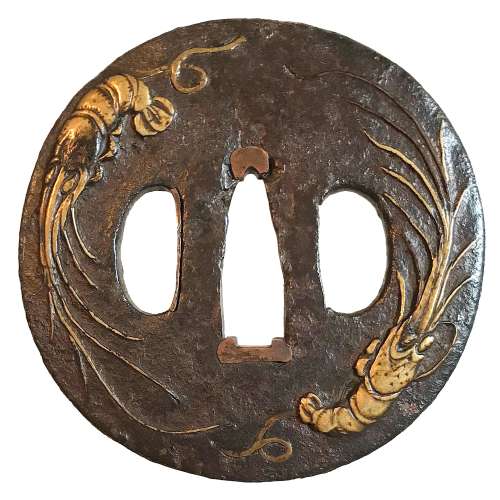 Iron tsuba of round form with two ebi (lobster) on omote (obverse side) and shika (deer) among scattered momiji (maple leaves) on ura (reverse side) motif in brass takabori (high relief) suemon-zōgan. Traces of lacquer. Unsigned. Late Muromachi / Momoyama period (late 16th / Early 17th century). Dimensions: 69.0.6 mm (H) x 69.6 mm (W) x 3.4 mm (T, seppa-dai). Weight: 92.6 g. Illustrated at: The Lundgren Collection of Japanese Swords, Sword Fittings and A Group of Miochin School Metalwork. Christie's Auction: Tuesday, 18 November 1997, London. Sales "GOTO-5881". Christie's, 1997. - #2 at page 7. Provenance: The second John Harding; The Lundgren Collection. Description at Christie's: "The iron plate depicting two lobsters in takabory and brass takazogan, the reverse similarly decorated with deer among scattered maple leaves, square mimi, late Muromachi / early Momoyama period (late 16th/early 17th century) Diameter 68 mm, mimi thickness 4 mm. Provenance: The second John Harding." Also at: JAPANESE SWORD-FITTINGS & METALWORK IN THE LUNDGREN COLLECTION. Published by Otsuka Kogeisha, Tokyo 1992. № 134. Description on page 173: Sword guard with design of shrimps in inlay (scarlet [sic] maple leaves and deer on the reverse side). Unsigned. Heianjō inlay school. Vertical 6.85 cm, horizontal 6.90 cm, Th. of rim 0.40 cm. Iron. Taka-bori relief and brass inlay. Momoyama period, 16th - 17th century. According to Merrily Baird, maple leaves, especially if paired with the deer, allude to autumnal tradition of Japanese aristocracy of viewing the seasonal changes of color in the Nara area. The lobster is typical Japanese ebi, - it lacks prominent claws, and has a spiny shell. As a symbol of longevity and good fortune, lobster is a staple of New Year's decoration.
Iron tsuba of round form with two ebi (lobster) on omote (obverse side) and shika (deer) among scattered momiji (maple leaves) on ura (reverse side) motif in brass takabori (high relief) suemon-zōgan. Traces of lacquer. Unsigned. Late Muromachi / Momoyama period (late 16th / Early 17th century). Dimensions: 69.0.6 mm (H) x 69.6 mm (W) x 3.4 mm (T, seppa-dai). Weight: 92.6 g. Illustrated at: The Lundgren Collection of Japanese Swords, Sword Fittings and A Group of Miochin School Metalwork. Christie's Auction: Tuesday, 18 November 1997, London. Sales "GOTO-5881". Christie's, 1997. - #2 at page 7. Provenance: The second John Harding; The Lundgren Collection. Description at Christie's: "The iron plate depicting two lobsters in takabory and brass takazogan, the reverse similarly decorated with deer among scattered maple leaves, square mimi, late Muromachi / early Momoyama period (late 16th/early 17th century) Diameter 68 mm, mimi thickness 4 mm. Provenance: The second John Harding." Also at: JAPANESE SWORD-FITTINGS & METALWORK IN THE LUNDGREN COLLECTION. Published by Otsuka Kogeisha, Tokyo 1992. № 134. Description on page 173: Sword guard with design of shrimps in inlay (scarlet [sic] maple leaves and deer on the reverse side). Unsigned. Heianjō inlay school. Vertical 6.85 cm, horizontal 6.90 cm, Th. of rim 0.40 cm. Iron. Taka-bori relief and brass inlay. Momoyama period, 16th - 17th century. According to Merrily Baird, maple leaves, especially if paired with the deer, allude to autumnal tradition of Japanese aristocracy of viewing the seasonal changes of color in the Nara area. The lobster is typical Japanese ebi, - it lacks prominent claws, and has a spiny shell. As a symbol of longevity and good fortune, lobster is a staple of New Year's decoration. -
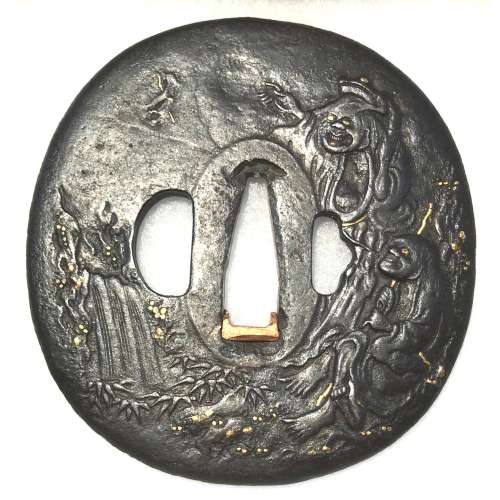
Iron tsuba of oval form with the design of two immortals (Gama Sennin with the toad upon his head and Tekkai Sennin with his iron crutch) beside a waterfall carved in low relief with a high relief effect (takabori) and with details inlaid in gold. A waterfall carved on the reverse. Nakago-ana is plugged with copper sekigane. Unsigned. Allegedly, Mito School.
Edo period, ca. 1700.
Size: Height: 87.0 mm; Width: 82.8 mm; Thickness: 4.4 mm; Weight: 179 g.
No longer available. -
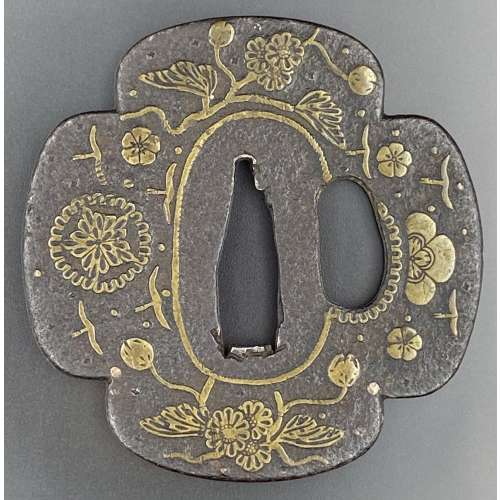 Iron tsuba of quatrefoil form (mokka-gata) adorned with the design of stars, wild geese, blossoms, leaves and tendrils realized in the brass inlay. The inlay technique includes suemon-zōgan and ten-zōgan. A smaller opening (kozuka hitsu-ana) surrounded by a scalloped brass border. The seppa-dai bordered with linear inlay. A few dots of inlay on both sides are missing. Measurements: height 71 mm, width 70 mm, thickness at centre 2.7 cm Time: Late Muromachi (1514 – 1573)
Iron tsuba of quatrefoil form (mokka-gata) adorned with the design of stars, wild geese, blossoms, leaves and tendrils realized in the brass inlay. The inlay technique includes suemon-zōgan and ten-zōgan. A smaller opening (kozuka hitsu-ana) surrounded by a scalloped brass border. The seppa-dai bordered with linear inlay. A few dots of inlay on both sides are missing. Measurements: height 71 mm, width 70 mm, thickness at centre 2.7 cm Time: Late Muromachi (1514 – 1573) -
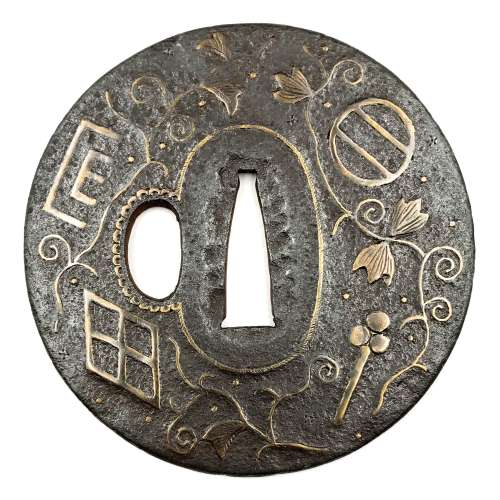 Thin iron tsuba of round form with design of family crests (mon) and arabesque (karakusa) in brass or copper inlay (suemon-zōgan) and occasional scattered brass dots or nail heads in ten-zōgan. Seppa-dai outlined with brass wire in the shape of a rope; kozuka-hitsu-ana outlined with scalloped brass wire. Rounded rim with iron bones (tekkotsu). The surface covered with lacquer (urushi). Ōnin school. Late Muromachi period, 16th century. Family crests on the face: 1:30: Two lines (double stripe) encircled (maruni futatsu biki). 4:30: Stylized clove (choji). 7:30: Divided rhombus, or four lozenges incorporated in one (wari-bishi); it is also called Takeda-bishi, the family crest of warrior Takeda Shingen (among the others). 10:00: Stylized Genji-mon (Genji kō-zu) or incense symbol. On the reverse: 2:00 - "Chinese cloud" not a crest. 5:00: Bit (Kutsuwa) 7:30: Number four in a fan (ōgi-san) 10:30: Two dots in a well frame (igeta).
Thin iron tsuba of round form with design of family crests (mon) and arabesque (karakusa) in brass or copper inlay (suemon-zōgan) and occasional scattered brass dots or nail heads in ten-zōgan. Seppa-dai outlined with brass wire in the shape of a rope; kozuka-hitsu-ana outlined with scalloped brass wire. Rounded rim with iron bones (tekkotsu). The surface covered with lacquer (urushi). Ōnin school. Late Muromachi period, 16th century. Family crests on the face: 1:30: Two lines (double stripe) encircled (maruni futatsu biki). 4:30: Stylized clove (choji). 7:30: Divided rhombus, or four lozenges incorporated in one (wari-bishi); it is also called Takeda-bishi, the family crest of warrior Takeda Shingen (among the others). 10:00: Stylized Genji-mon (Genji kō-zu) or incense symbol. On the reverse: 2:00 - "Chinese cloud" not a crest. 5:00: Bit (Kutsuwa) 7:30: Number four in a fan (ōgi-san) 10:30: Two dots in a well frame (igeta). -
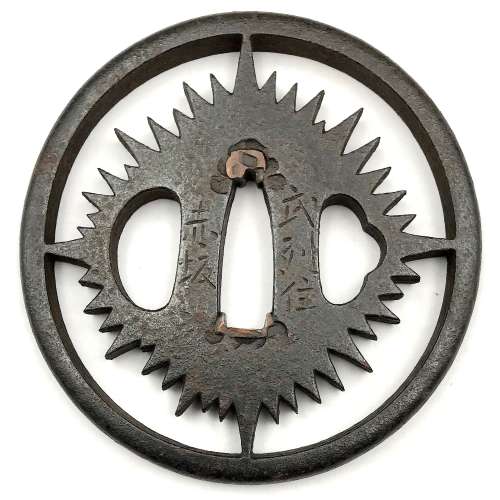 Iron tsuba of round form with slanting rays of light (shakoh) Christian motif (Jesuit’s IHS symbol) in openwork (sukashi). Traditional description of this kind of design is called “tokei”, or “clock gear”. Signed: On the face: Bushu ju Akasaka; On the back: Tadatoki Saku [Made by Tadatoki, resident of Bushu]. Probably, 4th generation of Akasaka School master Tadatoki (忠時), who died in 1746. Akasaka School. Edo period, first half of the 18th century. Size: 79.8 x 78.5 x 6.5 mm
Iron tsuba of round form with slanting rays of light (shakoh) Christian motif (Jesuit’s IHS symbol) in openwork (sukashi). Traditional description of this kind of design is called “tokei”, or “clock gear”. Signed: On the face: Bushu ju Akasaka; On the back: Tadatoki Saku [Made by Tadatoki, resident of Bushu]. Probably, 4th generation of Akasaka School master Tadatoki (忠時), who died in 1746. Akasaka School. Edo period, first half of the 18th century. Size: 79.8 x 78.5 x 6.5 mm -
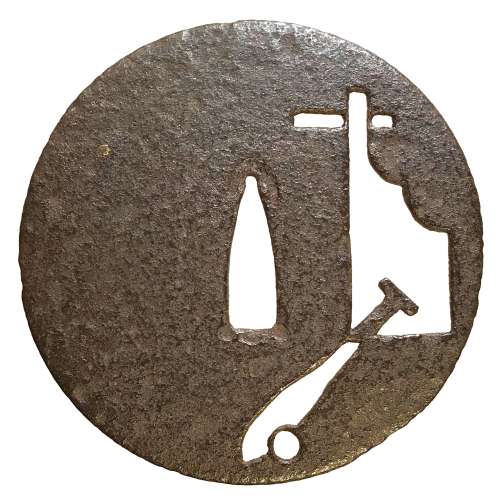 Round tsuba of iron; well forged thin plate decorated with a rudder (kaji) and an oar, or paddle (kai) with a water drop, executed in a combination of negative (in-sukashi) and positive (ji-sukashi) openwork. It may be Ko-Tōshō (old Tōshō) or just Tōshō school, without a 'Ko'. The characteristics of the plate point toward an older piece, however the combination of negative and positive silhouettes pulls the date of manufacture in an opposite direction. Muromachi period. Height: 90.0 mm. Width: 89.0 mm. Rim thickness: 2.1 mm. Center thickness: 2.3 mm. Nakago-ana: height = 29 mm, width = 8.8 mm. A rudder and an oar design is classified by John W. Dower as "Sailing vessels and gear": "Unlike many other motifs, sailing vessels and sailing gear failed to collect an interesting lore or to develop levels of meaning." Merrily Baird does not say anything about these symbols. Yuzuri Okada says: "Ships, sails, rudders, etc. also supply motive of the same class as wheels." He does not provide us with the description of the motive supplied by the wheel. The same motif is used on Ōnin tsuba in this collection:
Round tsuba of iron; well forged thin plate decorated with a rudder (kaji) and an oar, or paddle (kai) with a water drop, executed in a combination of negative (in-sukashi) and positive (ji-sukashi) openwork. It may be Ko-Tōshō (old Tōshō) or just Tōshō school, without a 'Ko'. The characteristics of the plate point toward an older piece, however the combination of negative and positive silhouettes pulls the date of manufacture in an opposite direction. Muromachi period. Height: 90.0 mm. Width: 89.0 mm. Rim thickness: 2.1 mm. Center thickness: 2.3 mm. Nakago-ana: height = 29 mm, width = 8.8 mm. A rudder and an oar design is classified by John W. Dower as "Sailing vessels and gear": "Unlike many other motifs, sailing vessels and sailing gear failed to collect an interesting lore or to develop levels of meaning." Merrily Baird does not say anything about these symbols. Yuzuri Okada says: "Ships, sails, rudders, etc. also supply motive of the same class as wheels." He does not provide us with the description of the motive supplied by the wheel. The same motif is used on Ōnin tsuba in this collection:
-
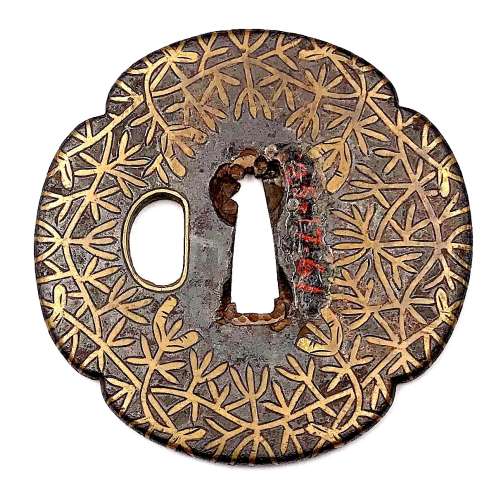 Iron tsuba of mokko form decorated with brass flat inlay (hira-zōgan) all over on both sits and going over the rounded rim. Black patina, well-forged iron. Hitsu-ana outlined with brass inlay. Former owner's catalogue number in red paint reads 25-17-61. Gary D. Murtha provides detailed account of this type of tsuba in Japanese Sword Guards. Onin-Heianjo-Yoshiro book on pages 118-122. He calls this type of tsuba "Heianjo Mogusa Tsuba": "The term mogusa is commonly used for an inlay design that represents an aquatic weed, similar to a duck weed or sago plant, which is known to quickly invade and overtake bodies of water. [...] Perhaps the visual image has some cross-over meaning for samurai in that, like the plant, a small aggressive samurai force could conquer a larger foe/area." I tried to find any reference to "mogusa" in literature, - to no avail. Neither on the vastness of internet, including Wikipedia... I did find the "duckweed" (one word), but visually it has nothing to do with the pattern on tsuba. "Sago plant" probably stands for 'Sago palm", and there is some very distant reminiscence in the construction of the sago palm leaf and the said design of inlay, but I would not go that far. In the old catalogues, such as Naunton and Hawkshaw collections, this pattern as called "sea weed" and/or "conventional fir". I will stick to these descriptions, tested by the time, and leave the enigmatic "mogusa" alone. Obviously, this type of tsuba has transformed into Yoshirō tsuba, both in Kaga province and Bizen province. Momoyama period (ca. 1660). Dimensions: 74.5 x 73.7 x 4.4 mm.
Iron tsuba of mokko form decorated with brass flat inlay (hira-zōgan) all over on both sits and going over the rounded rim. Black patina, well-forged iron. Hitsu-ana outlined with brass inlay. Former owner's catalogue number in red paint reads 25-17-61. Gary D. Murtha provides detailed account of this type of tsuba in Japanese Sword Guards. Onin-Heianjo-Yoshiro book on pages 118-122. He calls this type of tsuba "Heianjo Mogusa Tsuba": "The term mogusa is commonly used for an inlay design that represents an aquatic weed, similar to a duck weed or sago plant, which is known to quickly invade and overtake bodies of water. [...] Perhaps the visual image has some cross-over meaning for samurai in that, like the plant, a small aggressive samurai force could conquer a larger foe/area." I tried to find any reference to "mogusa" in literature, - to no avail. Neither on the vastness of internet, including Wikipedia... I did find the "duckweed" (one word), but visually it has nothing to do with the pattern on tsuba. "Sago plant" probably stands for 'Sago palm", and there is some very distant reminiscence in the construction of the sago palm leaf and the said design of inlay, but I would not go that far. In the old catalogues, such as Naunton and Hawkshaw collections, this pattern as called "sea weed" and/or "conventional fir". I will stick to these descriptions, tested by the time, and leave the enigmatic "mogusa" alone. Obviously, this type of tsuba has transformed into Yoshirō tsuba, both in Kaga province and Bizen province. Momoyama period (ca. 1660). Dimensions: 74.5 x 73.7 x 4.4 mm. -
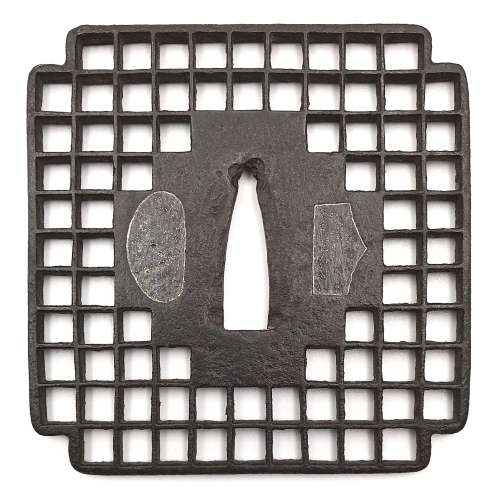
Iron tsuba of square with cut-off edges form (sumi-iri-kakugata) with lattice design in openwork (sukashi) and solid center. Hitsu-ana plugged with lead.
Unsigned. Late Muromachi period, ca. 16th century.
Size: 81.3 x 80.0 x 3.6 mm References: 1) Tsuba Kanshoki. Kazutaro Torogoye, 1975, p. 95, lower image. It's also called Kyō shōami. 2) KTK-11: Koshi motif, Late Muromachi (16th c.) -
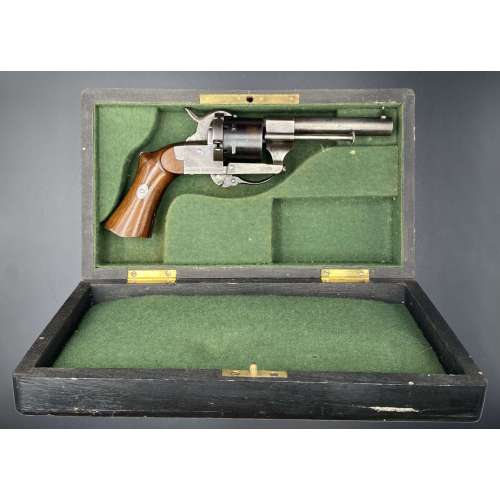
Lefaucheux model 1858 pin-fire self-cocking revolver with ejector rod, folding trigger and polished walnut grips, manufactured in Paris.
Stamped on barrel: E. LEFAUCHEUX BRte S.G.D.G. À PARIS.
Serial number LF 9018; in a wooden case. Dimensions: Case: 23 x 13 x 6 cm; L: 20.5 cm; H: 9 cm; Barrel: 9 cm. Eugene Lefaucheux (French, 1820 – 1871) was the son of Casimir Lefaucheux (French, 1802 – 1852). -
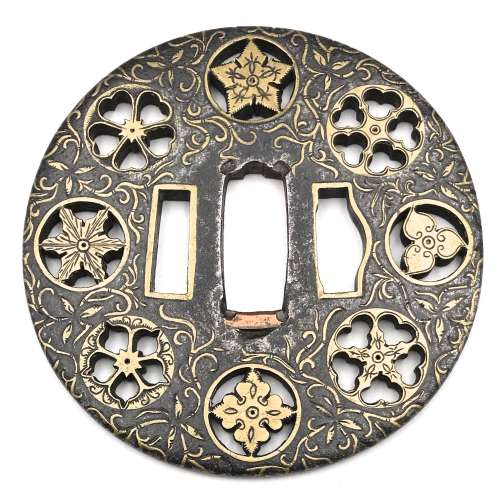 Iron tsuba of round form decorated with eight roundels – circular emblems of flowers and/or family crests (mon) made of cast brass, pierced and chiseled in kebori, and with flat brass inlay (hira-zōgan) of vines or leaves all over the plate. Both hitsu-ana trimmed in brass. Nakago-ana of rectangular form, with copper sekigane. Four positive openwork (ji-sukashi) roundels at 12, 3, 6, and 9 o'clock; and four negative openwork (in-sukashi) roundels with cherry blossom, bellflower, and two variations on suhama theme. Yoshirō school (Kaga-Yoshirō). The Momoyama or early Edo period, late 16th to early 17th century. Size: diameter 81.4 mm, thickness 4.7 mmat seppa-dai, 4.0 mm at rim. Christie's lot description: AN IRON TSUBA; EDO PERIOD (17TH CENTURY). THE DOLPHYN COLLECTION OF SAMURAI ART. The round iron tsuba pierced with roundels of various floral motifs interspersed among scrolling foliage, all inlaid with brass. 8.1 cm. high. Provenance: Pabst Collection (no. 338).
Iron tsuba of round form decorated with eight roundels – circular emblems of flowers and/or family crests (mon) made of cast brass, pierced and chiseled in kebori, and with flat brass inlay (hira-zōgan) of vines or leaves all over the plate. Both hitsu-ana trimmed in brass. Nakago-ana of rectangular form, with copper sekigane. Four positive openwork (ji-sukashi) roundels at 12, 3, 6, and 9 o'clock; and four negative openwork (in-sukashi) roundels with cherry blossom, bellflower, and two variations on suhama theme. Yoshirō school (Kaga-Yoshirō). The Momoyama or early Edo period, late 16th to early 17th century. Size: diameter 81.4 mm, thickness 4.7 mmat seppa-dai, 4.0 mm at rim. Christie's lot description: AN IRON TSUBA; EDO PERIOD (17TH CENTURY). THE DOLPHYN COLLECTION OF SAMURAI ART. The round iron tsuba pierced with roundels of various floral motifs interspersed among scrolling foliage, all inlaid with brass. 8.1 cm. high. Provenance: Pabst Collection (no. 338). -
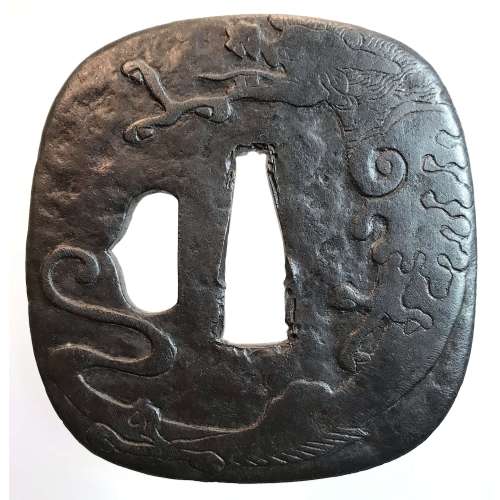 Shimizu-Jingo tsuba with a dragon and vajra (on reverse) motif. Unsigned. Possibly, 3rd or 4th master of Shimizu-Jingo family in Higo province. Iron. Low relief carving. Edo period, 1700's. Height: 75.4 mm, Width: 72.2 mm, Thickness at seppa-dai: 4.0 mm
Shimizu-Jingo tsuba with a dragon and vajra (on reverse) motif. Unsigned. Possibly, 3rd or 4th master of Shimizu-Jingo family in Higo province. Iron. Low relief carving. Edo period, 1700's. Height: 75.4 mm, Width: 72.2 mm, Thickness at seppa-dai: 4.0 mm -
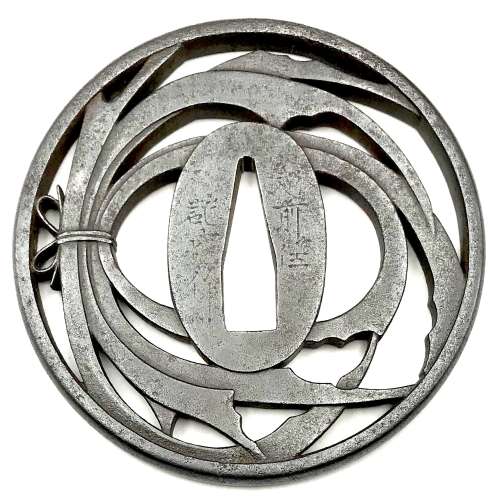
Iron tsuba of round form pierced (sukashi) and carved (marubori) with a 'noshi' decoration design. Noshi - decoration made of dried abalone (awabi) and bearing an auspicious connotation of good fortune, prosperity, etc. Design was used as a family crest (mon).
Size: 76.3 x 75.9 x 5.5 mm.
Signed: Echizen jū Kinai Saku. Kinai school existed from mid 17th to mid 19th century; it is hard to tell which master (generation from 1 to 6) made this particular piece.
SOLD -
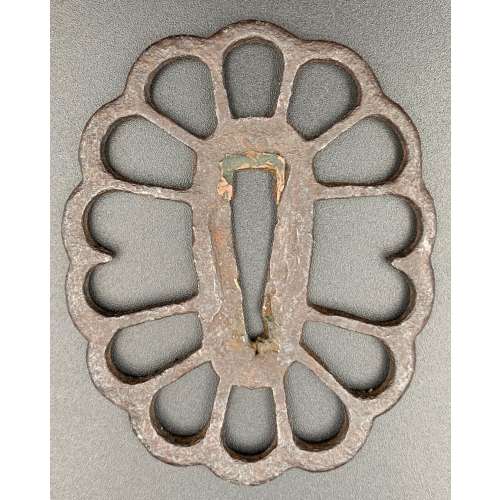
Iron tsuba with chrysanthemum design in openwork (sukashi). Copper sekigane.
Late Heian through Kamakura period (ca. 1150 - 1200's).
Size: 78.4 x 60.9 x 3.5 mm; weight: 45.7 g
Provenance: Boris Markhasin Message from Boris Markhasin (13-AUG-2019): It is a very rudimentary tachi tsuba, and the iron is old and really nothing to draw attention. However, this is a very old tsuba, and that is what makes it very special and an important study piece. This tsuba likely dates to the late Heian through Kamakura (ca. 1150 - 1200's) -- by consensus, since such examples are extremely rare, and none are mounted to my knowledge, so few direct analogues. The form is interesting for a variety of reasons. The smaller size, an oval form is associated more with 12th/13th c styles. The sukashi kiku motif is very interesting as it clearly pushes back the dating of large scale sukashi far back in time. This shouldn't be surprising, but for some reason, we (really mainly westerners) naively tend to associate sukashi with the Muromachi and younger. The two missing spokes are by consensus likely later removals to accommodate kozuka and kogai -- but this is not certain, and it could be an original styling. A key kantei point is the elongate, narrow, slightly squared seppa dai. This is a characteristic of early koshirae, which were much thinner and more delicate than the types we are used to seeing that date pretty much to the late Muromachi and later. I am always amazed when I have a chance to interrogate early koshirae at how thin they are - I want to call them fragile, but they were actually quite resilient. The walls were super thin, but the top and bottom edges were a bit thicker, providing a bit of structural support... but this is another thread topic. Of all the tsuba I have owned, this is the tsuba that has most clearly reflected the shape of the old style of saya / tsuka. -
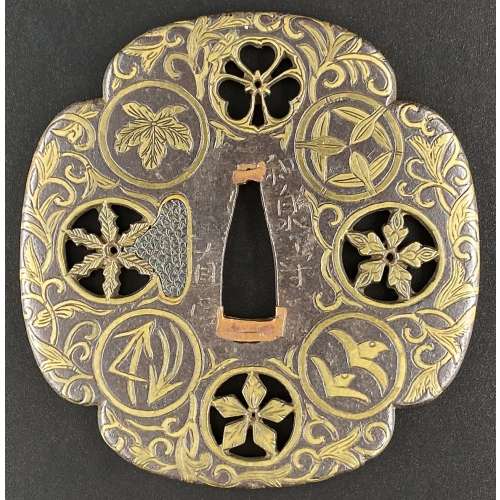 The so-called Yoshirō-tsuba [与四郎鐔] with an iron plate of mokkō form densely decorated with floral arabesque and adorned with eight pierced, chiselled and inlaid brass roundels and signed on both sides 'Koike Yoshirō Izumi no Kami Naomasa'. Four of the roundels are pierced and have geometrical designs representing flowers (e.g. wood sorrel) or snowflakes. Four others are solid and represent family crests; on one side: Mulberry (kaji) – mon of the Matsunaga clan [松永氏], Bamboo Grass (sasa) – mon of the Takenaka clan [竹中氏]), Wild Geese (kari) – mon of the Shibata clan [新発田氏]), and Pine Needles (matsuba); on the other side: Nine Stars (kuyō) – the Hosokawa clan [細川氏], Paulownia (kiri) – the Toyotomi clan [豊臣氏]), Bamboo Leaves (take) – the Minamoto clan [源], and Seven Treasures (shippo) – Izumo Genji clan [出雲源氏]. Hitsu-ana obliterated with a nanako-treated pewter plug. Brass with rainbow patina. Artist: Koike Izumi no Kami Naomasa (Japanese, active late 16th – early 17th century). The Momoyama or early Edo period, end of the 16th to the first half of the 17th century (1574-1650). Size: 81.7 x 78.8 x 4.3 cm. Provenance: Dr. Kazutaro Torigoye. Special thanks to Markus Sesko for providing the translation of hakogaki. Hakokaki lid (outside): 小池与四郎 – Koike Yoshirō Hakokaki lid (inside): 銘曰小池与四郎 – Mei’etsu: Koike Yoshirō – Signed: Koike Yoshirō 和泉守直正 – Izumi no Kami Naomasa – Izumi no Kami Naomasa 木瓜形 鉄地 – Mokkōgata, tetsu-ji – Lobed shape, of iron 真鍮据紋象嵌 – Shinchū suemon-zōgan – with brass suemon-zōgan inlay 縦二寸七分横二寸六分 – Tate ni-sun shichi-bu, yoko ni-sun roku-bu – Height 8.2 cm, width 7.9 cm 右正真也 – Migi shōshin nari – Above described object is authentic 昭和廾九年八月十一日 – Shōwa nijūkyūnen hachigatsu jūichinichi – August 11, 1954 草堂「花押」– Sōdō + kaō – Sōdō [pen name of Torigoye Kazutarō, 鳥越一太郎] + monogram Ref.: (1) Tsuba Geijutsu-Ko by Kazutaro Torigoye, 1960; (2) Tsuba. An aesthetic study. By Kazutaro Torigoye and Robert E. Haynes from the Tsuba Geijutsu-kō of Kazataro Torigoye. Edited and published by Alan L. Harvie for the Nothern California Japanese Sword Club, 1994-1997, p. Yoshirō, 4. See also Yoshirō tsuba.
The so-called Yoshirō-tsuba [与四郎鐔] with an iron plate of mokkō form densely decorated with floral arabesque and adorned with eight pierced, chiselled and inlaid brass roundels and signed on both sides 'Koike Yoshirō Izumi no Kami Naomasa'. Four of the roundels are pierced and have geometrical designs representing flowers (e.g. wood sorrel) or snowflakes. Four others are solid and represent family crests; on one side: Mulberry (kaji) – mon of the Matsunaga clan [松永氏], Bamboo Grass (sasa) – mon of the Takenaka clan [竹中氏]), Wild Geese (kari) – mon of the Shibata clan [新発田氏]), and Pine Needles (matsuba); on the other side: Nine Stars (kuyō) – the Hosokawa clan [細川氏], Paulownia (kiri) – the Toyotomi clan [豊臣氏]), Bamboo Leaves (take) – the Minamoto clan [源], and Seven Treasures (shippo) – Izumo Genji clan [出雲源氏]. Hitsu-ana obliterated with a nanako-treated pewter plug. Brass with rainbow patina. Artist: Koike Izumi no Kami Naomasa (Japanese, active late 16th – early 17th century). The Momoyama or early Edo period, end of the 16th to the first half of the 17th century (1574-1650). Size: 81.7 x 78.8 x 4.3 cm. Provenance: Dr. Kazutaro Torigoye. Special thanks to Markus Sesko for providing the translation of hakogaki. Hakokaki lid (outside): 小池与四郎 – Koike Yoshirō Hakokaki lid (inside): 銘曰小池与四郎 – Mei’etsu: Koike Yoshirō – Signed: Koike Yoshirō 和泉守直正 – Izumi no Kami Naomasa – Izumi no Kami Naomasa 木瓜形 鉄地 – Mokkōgata, tetsu-ji – Lobed shape, of iron 真鍮据紋象嵌 – Shinchū suemon-zōgan – with brass suemon-zōgan inlay 縦二寸七分横二寸六分 – Tate ni-sun shichi-bu, yoko ni-sun roku-bu – Height 8.2 cm, width 7.9 cm 右正真也 – Migi shōshin nari – Above described object is authentic 昭和廾九年八月十一日 – Shōwa nijūkyūnen hachigatsu jūichinichi – August 11, 1954 草堂「花押」– Sōdō + kaō – Sōdō [pen name of Torigoye Kazutarō, 鳥越一太郎] + monogram Ref.: (1) Tsuba Geijutsu-Ko by Kazutaro Torigoye, 1960; (2) Tsuba. An aesthetic study. By Kazutaro Torigoye and Robert E. Haynes from the Tsuba Geijutsu-kō of Kazataro Torigoye. Edited and published by Alan L. Harvie for the Nothern California Japanese Sword Club, 1994-1997, p. Yoshirō, 4. See also Yoshirō tsuba. -
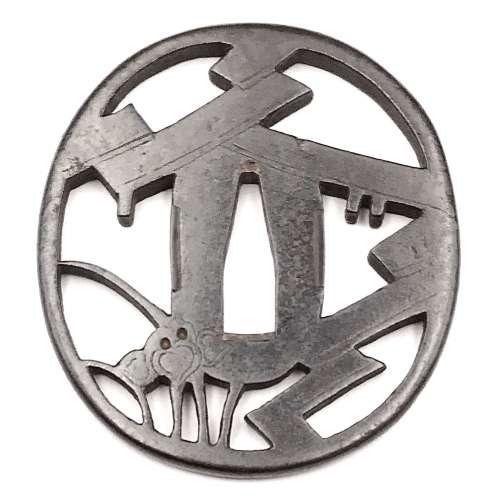 Iron tsuba of oval form with design of iris and plank bridge (yatsubashi) in openwork (sukashi). Rounded cornered rim. Unsigned. Attributed to Jingo - 3rd generation Shimizu, 2nd generation Jingo (1691-1777) [M. Sesko, Genealogy..., p. 94]. Edo period: Late 18th century (Hohreki / Meiwa era). Height: 69.5 mm. Width: 65.2 mm. Rim thickness: 4.6 mm. Center thickness: 4.8 mm. Provenance: Sasano Masayuki Collection, № 251: "Shimizu. Third generation Jingo (died at 87 years of age in the sixth year of An-ei, 1777). The eight-section bridge with irises are arranged to create the design of 'yatsubashi'. The features are unique for the Shimizu school and show no influence of the Hirita, Nishigaki or Hayashi schools". The design visually resembles a butterfly. As described in Family Crests of Japan by Stone Bridge Press [Family Crests of Japan; Stone Bridge Press, Berkeley, CA, 2007], and also in Japanese Family Crests by Yuzuru Okada [Yuzuru Okada. Japanese Family Crests // Series: Tourist Library: 37. Board of tourist industry; Japanese Government Railways, - 1941], there is a special technique used in construction of family crests, called 'reshaping' by the former and 'reconstruction' by the latter: "reconstruction is realized when a motive has its general shape composed of the detail of entirely different motive as, for instance, the crest of a butterfly formed of pine-needles. [...] The fanciful and ingenious forms evolved in this way may be represented by the kasiwa-giri or 'oak-leaf-paulownia', the ogi-bisi or 'fan-lozenge', the matuba-zuru or 'pine-needle-crane', the omodaka-kotyo or 'water-plantain-butterfly', etc." In our case we can call the motif yatsubashi-chocho or 'Iris-and-Bridge—Butterfly'.
Iron tsuba of oval form with design of iris and plank bridge (yatsubashi) in openwork (sukashi). Rounded cornered rim. Unsigned. Attributed to Jingo - 3rd generation Shimizu, 2nd generation Jingo (1691-1777) [M. Sesko, Genealogy..., p. 94]. Edo period: Late 18th century (Hohreki / Meiwa era). Height: 69.5 mm. Width: 65.2 mm. Rim thickness: 4.6 mm. Center thickness: 4.8 mm. Provenance: Sasano Masayuki Collection, № 251: "Shimizu. Third generation Jingo (died at 87 years of age in the sixth year of An-ei, 1777). The eight-section bridge with irises are arranged to create the design of 'yatsubashi'. The features are unique for the Shimizu school and show no influence of the Hirita, Nishigaki or Hayashi schools". The design visually resembles a butterfly. As described in Family Crests of Japan by Stone Bridge Press [Family Crests of Japan; Stone Bridge Press, Berkeley, CA, 2007], and also in Japanese Family Crests by Yuzuru Okada [Yuzuru Okada. Japanese Family Crests // Series: Tourist Library: 37. Board of tourist industry; Japanese Government Railways, - 1941], there is a special technique used in construction of family crests, called 'reshaping' by the former and 'reconstruction' by the latter: "reconstruction is realized when a motive has its general shape composed of the detail of entirely different motive as, for instance, the crest of a butterfly formed of pine-needles. [...] The fanciful and ingenious forms evolved in this way may be represented by the kasiwa-giri or 'oak-leaf-paulownia', the ogi-bisi or 'fan-lozenge', the matuba-zuru or 'pine-needle-crane', the omodaka-kotyo or 'water-plantain-butterfly', etc." In our case we can call the motif yatsubashi-chocho or 'Iris-and-Bridge—Butterfly'. -
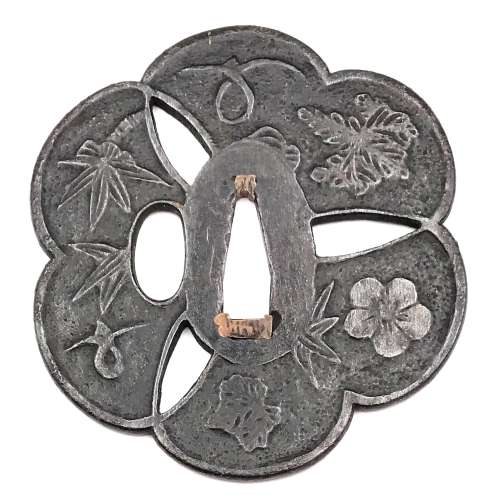 Six-lobed iron tsuba in a form of three ginkgo tree leaves (icho), separated with three small triangular openings (ko-sukashi). Leaves have raised rim and decorated with various family crests (mon) in low relief carving (sukidashi-bori). On obverse: bamboo stems and leaves, knotted geese, paulownia (kiri), plum blossom (ume), and ivy. On reverse: pine needles and cone, maple leaf (kaede), bamboo, stylized plum blossom, and Genji-mon. Black patina. Kozuka hitsu-ana is original, with raised rim. Copper sekigane. Kamakura-bori school. Late Muromachi period (ca. 1550). Size: Height: 81.1 mm. Width: 90.0 mm. Thickness at seppa-dai: 3.3 mm. Weight: 120.4 g.
Six-lobed iron tsuba in a form of three ginkgo tree leaves (icho), separated with three small triangular openings (ko-sukashi). Leaves have raised rim and decorated with various family crests (mon) in low relief carving (sukidashi-bori). On obverse: bamboo stems and leaves, knotted geese, paulownia (kiri), plum blossom (ume), and ivy. On reverse: pine needles and cone, maple leaf (kaede), bamboo, stylized plum blossom, and Genji-mon. Black patina. Kozuka hitsu-ana is original, with raised rim. Copper sekigane. Kamakura-bori school. Late Muromachi period (ca. 1550). Size: Height: 81.1 mm. Width: 90.0 mm. Thickness at seppa-dai: 3.3 mm. Weight: 120.4 g. -
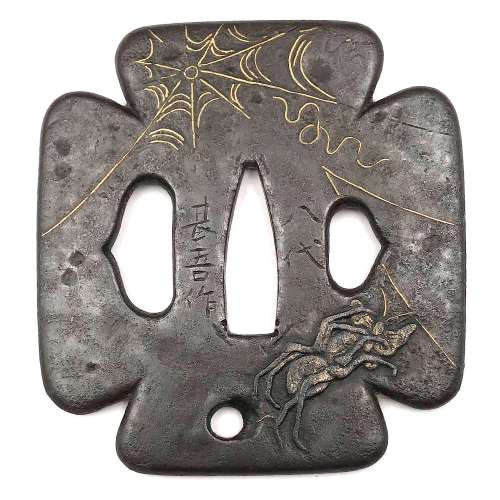
Very fine iron plate well hammered and turned, tapering and rolling to the rounded edge. Tsuba of a cross-form mokko shape (juji-mokko-gata) decorated with spider web inlaid in gold on both sides. The face is carved with a silver-damascened spider holding a gold-damascened butterfly (nunome-zōgan). Kozuka and kogai hitsu-ana of inome (boar's eye) form. The udenuki ana may be of purely decorative purpose.
Signed: Yatsushiro [八代] Jingo Saku [甚吾作], a signature of Chisokutei Amatsune, one of the last Jingo masters.
Late Edo period, Tenpō era, 1830-1844.Size: Height: 77.5 mm; Width: 72.8 mm; Thickness: 4.1 mm; Weight: 141 g.
In a custom wooden box.
Here is what Markus Sesko wrights in his book The Japanese toso-kinko Schools, 2012, on page 374:An artist who worked in the style of the Shimizu-Jingo school was Chisokutei Amatsune (知足亭天常). He was actually a samurai from Yatsushiro who made tsuba as a sideline. An extant old hakogaki of one of his pieces mentions that he died in Edo in the sixth month of An'ei eight (1779) at the age of 73. But the era of An'ei is probably wrong because Chikokutei (sic) is today dated by most experts around Tenpō (1830-1844). His relationships with the Shimizu school or under which Jingo master he had studied are unknown. From the point of view of production time and the finishing of nakago-ana, he is rather associated with the 5th and last gen. Shigenaga who died in the seventh year of Kaei (1854). A peculiarity of Chisokutei was that he signed his Jingo copies with "Yatsushiro Jingo Saku" ([八代甚吾作) but added the small syllable "chi" (チ) or the character "Chi" (知) for "Chisokutei" to identify them as copies.
No longer available. -
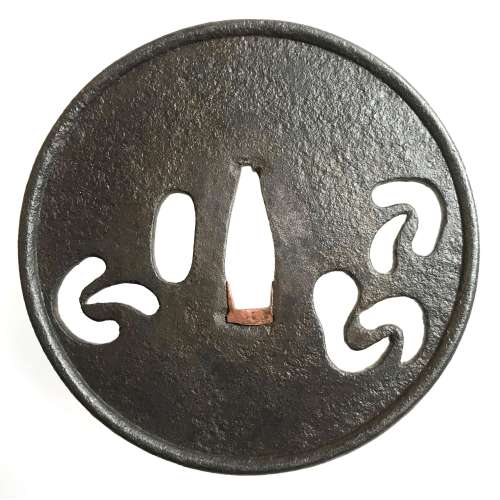 Iron tsuba of round form decorated with design of pine tree mushrooms (matsutake) in openwork (sukashi). Hitsu-ana of elongated oval form. Raised rim (mimi) with iron bones (tekkotsu). Copper sekigane. Size: 84.5 mm x 85.1 mm; thickness: 3.0 mm (center), 5.6 mm (rim). Mid Muromachi period, 15th century. The shape and width of the rim, as well as the shape of the hitsu-ana, argue for earlier Muromachi. Tsuba is slightly wider than high, that might suggest middle of Muromachi age. According to Robert Haynes, circa 1450-1500.
Iron tsuba of round form decorated with design of pine tree mushrooms (matsutake) in openwork (sukashi). Hitsu-ana of elongated oval form. Raised rim (mimi) with iron bones (tekkotsu). Copper sekigane. Size: 84.5 mm x 85.1 mm; thickness: 3.0 mm (center), 5.6 mm (rim). Mid Muromachi period, 15th century. The shape and width of the rim, as well as the shape of the hitsu-ana, argue for earlier Muromachi. Tsuba is slightly wider than high, that might suggest middle of Muromachi age. According to Robert Haynes, circa 1450-1500. -

Iron tsuba in a form of an eight-petalled blossom (lotus) form, petals separated by linear low-relief carving, both hitsu-ana filled with gold plugs, the surface decorated with tsuchime-ji, rich grey-brownish patina, niku from 4 mm in the centre to 6 mm at the rim. Strong (futoji-mei) Nobuie [信家] signature to the left of nakago-ana. Attributed to the 2nd generation of Nobuie masters (Nidai Nobuie).
Size: outer diameter 84 mm, thickness at centre: 4 mm, at rim: 6 mm. Wight: 167 g.Signed: Nobuie [信家]
Probably the work of Nidai Nobuie (c. 1600).
The gold plugs are likely a later work. -
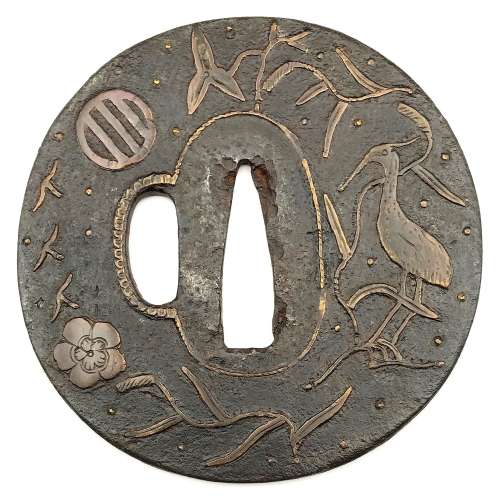 Iron tsuba of round form profusely decorated with brass inlay of plants, birds, well, and family crests (mon) in suemon-zōgan technique and occasional brass dots (nail-heads) or ten-zōgan. Seppa-dai and kozuka-hitsu-ana outlined with brass inaly, possibly repaired: rope-shaped wire here and there replaced with flat wire. The plate is very thin, with remnants of lacquer. Ōnin school. Size: 75.8 x 75.2 x 2.3 mm. Weight: 77.5 g. On the front side (omote) motif includes the following elements (from 12 o'clock, clockwise):
Iron tsuba of round form profusely decorated with brass inlay of plants, birds, well, and family crests (mon) in suemon-zōgan technique and occasional brass dots (nail-heads) or ten-zōgan. Seppa-dai and kozuka-hitsu-ana outlined with brass inaly, possibly repaired: rope-shaped wire here and there replaced with flat wire. The plate is very thin, with remnants of lacquer. Ōnin school. Size: 75.8 x 75.2 x 2.3 mm. Weight: 77.5 g. On the front side (omote) motif includes the following elements (from 12 o'clock, clockwise):- Water plantain (a.k.a. arrowhead, or omodaka): "a perpetual plant of the water plantain family, was also called shōgunsō (victorious army grass). Because of this martial connotation, it was a design favored for the crests of samurai families" [see: Family Crests of Japan. // Stone Bridge Press, Berkeley, CA, 2007; p. 63].
- Heron (sagi): "...considered an emblem of longevity, and from China comes the practice of regarding the bird as a mount of the gods and the Taoist sennin. [...] heron also reflects an inauspicious connotation, for the word sagi is homophone for 'fraud' and 'false pretenses'." [see: Merrily Baird. Symbols of Japan. Thematic motifs in art and design. // Rizzoli international publications, Inc., 2001; p. 112]. Some may say, that this is not a heron but a crane (tsuru). It's very possible, and in this case the negative connotation is lost, but the reference to longevity and allusion to sennin remain.
- Pampas grass (susuki, or obana): as per Merrily Baird, p. 95 and John W. Dower, p. 66, pampas grass is one of the Seven Grasses of Autumn. When combined with flying wild gees, conveys strong autumnal mood.
- Plum blossom (ume): according to Merrily Baird, the flower has a vast variety of symbolic meanings, including longevity, and a reference to the Chinese Taoists. It is used in 80 family crests [see: Japanese Design Motifs: 4,260 Illustrations of Japanese Crests; Compiled by the Matsuya Piece-Goods Store; Translated by Fumie Adachi. // Dover Publications, Inc., 1972.] Plum is "celebrated for its sweet perfume, delicate blossoms, and habit of blooming at the end of winter".
- Tree flying wild geese (kari): "Wild geese arrive in large flocks in southern regions during the autumn months, and following their migratory instincts, head back north in spring" [Family Crests of Japan, pp. 85-86]. "The importance of geese in Japanese art was further secured by stories of several military heroes who had achieved victory in battle when a sudden breaking of ranks by flying geese signaled an ambush. The protective role of the birds led to their frequent use in decorating sword furnishings and possibly also their adoption as a family crest motif.Finally, the goose in Asia plays a role in religious traditions" [Merrily Baird, pp.111-112].
- Hikiryō (line, or bar, or stripe) - a symbol which consists of one, two, or three horizontal or vertical stripes in a circle. "In wartime, Japanese generals [...] surrounded their encampments with huge cloth curtains. Usually these were made of cloth sewn together horizontally and varying in color [...] to distinguish the individual general and his followers. The stripe thus assumed strong martial connotations, and became a mark of identification on personal military gear as well. In the early fourteenth century the heads of the Ashikaga and Nitta, then the two most powerful clans in Japan, both adopted stripe patterns as a family crest". [See: Family Crests of Japan, p. 111 and John W. Dower. The elements of Japanese design - A handbook of family crests, heraldry & symbolism. // Weatherhill, New York, Tokyo, 1985, p. 144].
- Hikiryō, see above.
- Pampas grass (susuki, or obana), see above.
- Bellflower (kikyo): One of the Seven Grasses of Autumn. "As a crest, it have been adopted among the warriors around the thirteenth century, primarily because of it's beauty" [John W. Dower, p. 48].
- Four flying wild geese (kari), see above.
- Weeping willow (yanagi): "It is commonly represented with water, snow, swallows, or herons. A branch of willow (yoshi) is one of the attributes of the Buddhist deity Senju Kannon (Thousand-Armed Kannon), who is said to use the branch to sprinkle the nectar of life contained in a vase. [Merrily Baird, pp. 66-67].
- Lone plum blossom in a well frame/crib (igeta, izitsu): "Well crib was one of the most popular motifs in Japanese heraldry". As a crest it may stay simply for the first character (i) of the family name, however, with a flower inside the well frame, and together with the other symbols present, it may aggravate the sense of autumn-ness. The ten-zōgan dots in this particular case may represent the snowflakes or autumn stars.
-
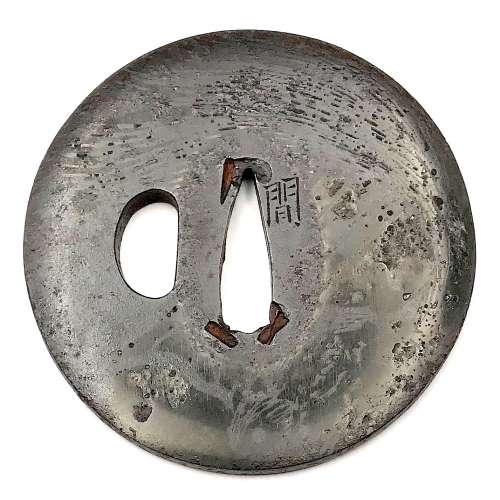 Iron tsuba of round form (width > height) decorated with a squirrel (on the face) and bamboo (on the reverse) motif in sahari flat inlay (hira-zōgan). Signed: Hazama (間) Size: 75.1mm x 75.9mm, thickness of seppa-dai 5.4mm. Early 18th century, mid Edo. Haynes/Torigoye: "There is another name for Hazama tsuba: the Kameyama school. In the period from Hōei to Kyōhō (1704-36) at Kameyama, in the province of Ise, the Kunitomo family made this style of tsuba" [...] The two artists who are best known for the sahari style of inlaid tsuba are Sadahide and Masahide" [...] The signature Hazama should be considered as that of Masahide". Sahari inlay is the distinctive characteristics of Hazama school. Sahari is an alloy of copper, tin, lead, zinc and silver. Hazama tsuba was carved patterns at first, then poured heated into the carvings on iron ground. Because it is an alloy, sahari shows different colors in each tsuba. According to Merrily Baird [Symbols, p. 163], "squirrels (risu) ... have no symbolic importance". NBTHK certificate №448388.
Iron tsuba of round form (width > height) decorated with a squirrel (on the face) and bamboo (on the reverse) motif in sahari flat inlay (hira-zōgan). Signed: Hazama (間) Size: 75.1mm x 75.9mm, thickness of seppa-dai 5.4mm. Early 18th century, mid Edo. Haynes/Torigoye: "There is another name for Hazama tsuba: the Kameyama school. In the period from Hōei to Kyōhō (1704-36) at Kameyama, in the province of Ise, the Kunitomo family made this style of tsuba" [...] The two artists who are best known for the sahari style of inlaid tsuba are Sadahide and Masahide" [...] The signature Hazama should be considered as that of Masahide". Sahari inlay is the distinctive characteristics of Hazama school. Sahari is an alloy of copper, tin, lead, zinc and silver. Hazama tsuba was carved patterns at first, then poured heated into the carvings on iron ground. Because it is an alloy, sahari shows different colors in each tsuba. According to Merrily Baird [Symbols, p. 163], "squirrels (risu) ... have no symbolic importance". NBTHK certificate №448388. -
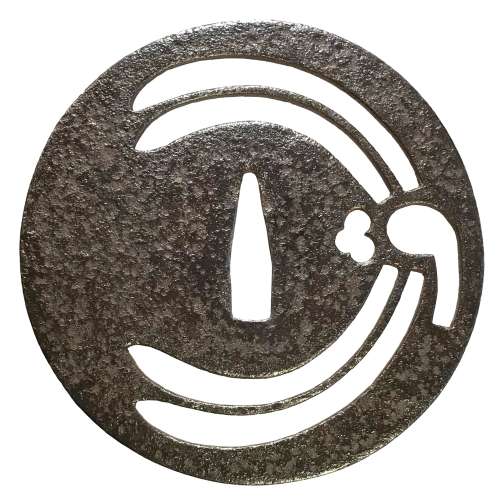 Iron tsuba of round form decorated with design of dragonfly in negative openwork (in-sukashi). It may be Ko-Tōshō (old Tōshō) or just Tōshō school, without a 'Ko'. Probably the dragonfly here is used as a family crest (mon). Muromachi period. Dimensions: Height: 95.0 mm. Width: 93.6 mm. Rim thickness: 2.1 mm. Center thickness: 2.3 mm. Nakago-ana: height = 30 mm, width = 7.8 mm. A dragonfly design is described by John W. Dower as following "During the period of feudal warfare, the dragonfly is reputed to have been am especially popular design applied to arrow quivers, and some warriors adopted it as a family crest. One reason for this was the insect's alternative names of katsu mushi and shogun mushi, both meaning 'victory insect'." Merrily Baird is even more talkative regarding the matter: "The dragonfly (tombo) in Japan is emblematic of martial success, as various names for the insect are homophones for words meaning "victory". The dragonfly is also auspicious because references in the Kojiki and Nihongi link it in both name and shape to the old kingdom of Yamato. This legacy has led to the use of dragonfly as an emblem on arrow quivers and as family crest. It also appears occasionally in conjunction with such imperial motifs as the chrysanthemum. Used in a context devoid of historical associations, the dragonfly is a seasonal symbol of late summer and early autumn." Dragonfly was an extremely often motif for the tsuba in all times, primarily in earlier times, before Tokugawa pacified the nation. The same motif is used on Ōnin tsuba in this collection:
Iron tsuba of round form decorated with design of dragonfly in negative openwork (in-sukashi). It may be Ko-Tōshō (old Tōshō) or just Tōshō school, without a 'Ko'. Probably the dragonfly here is used as a family crest (mon). Muromachi period. Dimensions: Height: 95.0 mm. Width: 93.6 mm. Rim thickness: 2.1 mm. Center thickness: 2.3 mm. Nakago-ana: height = 30 mm, width = 7.8 mm. A dragonfly design is described by John W. Dower as following "During the period of feudal warfare, the dragonfly is reputed to have been am especially popular design applied to arrow quivers, and some warriors adopted it as a family crest. One reason for this was the insect's alternative names of katsu mushi and shogun mushi, both meaning 'victory insect'." Merrily Baird is even more talkative regarding the matter: "The dragonfly (tombo) in Japan is emblematic of martial success, as various names for the insect are homophones for words meaning "victory". The dragonfly is also auspicious because references in the Kojiki and Nihongi link it in both name and shape to the old kingdom of Yamato. This legacy has led to the use of dragonfly as an emblem on arrow quivers and as family crest. It also appears occasionally in conjunction with such imperial motifs as the chrysanthemum. Used in a context devoid of historical associations, the dragonfly is a seasonal symbol of late summer and early autumn." Dragonfly was an extremely often motif for the tsuba in all times, primarily in earlier times, before Tokugawa pacified the nation. The same motif is used on Ōnin tsuba in this collection:
-
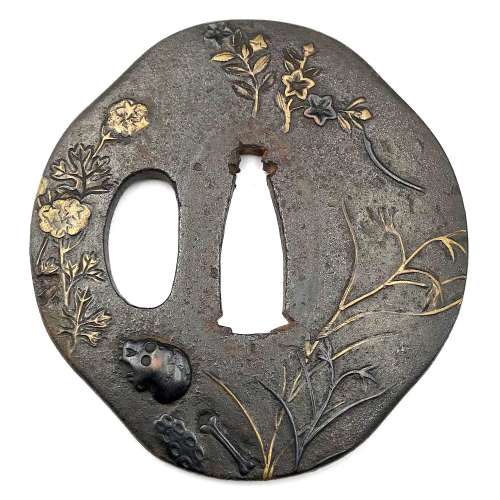 Iron tsuba of otafuku-gata form decorated on the face with death and autumn motifs: autumnal grasses and flowers in yellow brass and shakudō, skull, limb bone and sternum inlaid in shakudō. On the reverse the plate is inlaid in red copper with a chrysanthemum and maple leaves floating in stylized water streams. "Plants floating atop water form common motifs, as occurs with chrysanthemums, maple leaves, and cherry blossoms, in particular." [Merrily Baird]. Such plants may be used as a family crest (mon), or may be just a reminder of a floating nature of life. Momoyama period, late 15th century. Dimensions: 75.3 x 69.9 x 4.3 mm.
Iron tsuba of otafuku-gata form decorated on the face with death and autumn motifs: autumnal grasses and flowers in yellow brass and shakudō, skull, limb bone and sternum inlaid in shakudō. On the reverse the plate is inlaid in red copper with a chrysanthemum and maple leaves floating in stylized water streams. "Plants floating atop water form common motifs, as occurs with chrysanthemums, maple leaves, and cherry blossoms, in particular." [Merrily Baird]. Such plants may be used as a family crest (mon), or may be just a reminder of a floating nature of life. Momoyama period, late 15th century. Dimensions: 75.3 x 69.9 x 4.3 mm. -
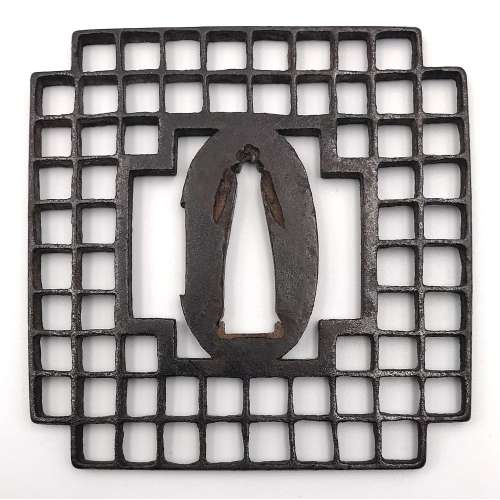
Iron tsuba of square with cut-off edges form (sumi-iri-kakugata) with lattice design in openwork (sukashi) and pierced center.
Unsigned. Late Muromachi period, ca. 16th century.
Size: 73.2 x 72.4 x 3.6 mm References: 1) Tsuba Kanshoki. Kazutaro Torogoye, 1975, p. 95, lower image. It's also called Kyō shōami. 2) KTK-11: Koshi motif, Late Muromachi (16th c.)


